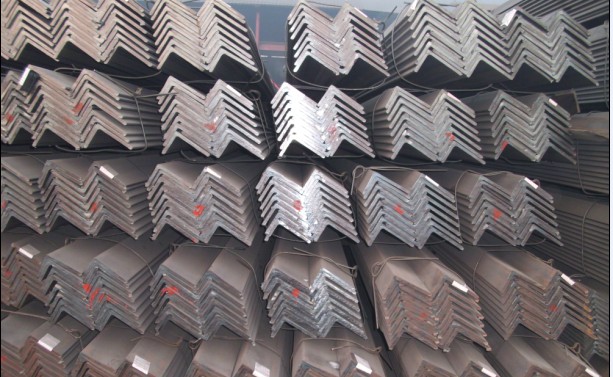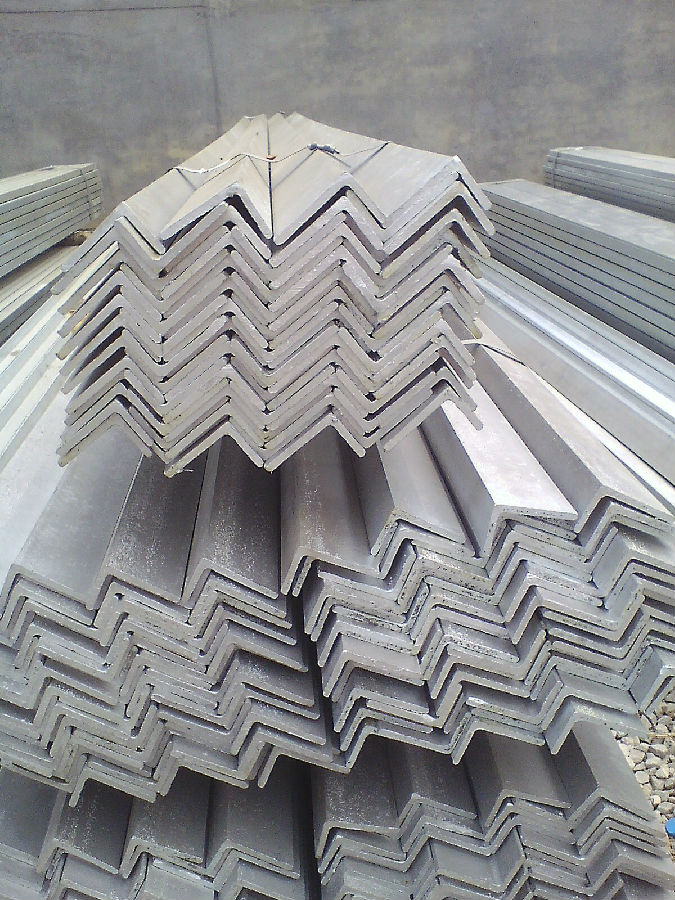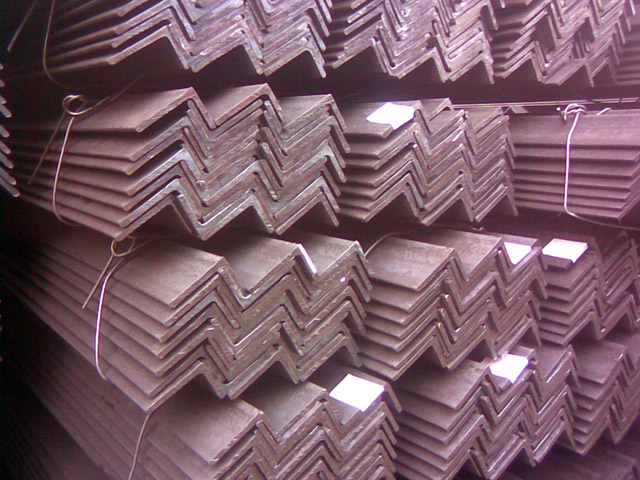Hot rolled angle steel GB Q235 or Q345B or equivalent
- Loading Port:
- Tianjin
- Payment Terms:
- TT OR LC
- Min Order Qty:
- 25 m.t.
- Supply Capability:
- 20000000 m.t./month
OKorder Service Pledge
OKorder Financial Service
You Might Also Like
Product Description:
Specifications
angle steel
1.size:25*16*3mm-200*125*18mm
2.quality:Q235,Q345,SS400,A36
3.length: 6m, 9m, 12m
4.unequal
angle steel
angle steel
(1)Material:Q235 SS400 S235JR OR ST37-2 Q345
(2)Size:25x16x3mm-200x125x18mm
(3)Certificate:ISO,CE
agle steel
angle steel



Angle called angle, the steel strip is perpendicular to each other on both sides into angular.Divided into equilateral angle steel and ranging from side angle. Two equilateral angle steel edge width is the same. The specification is expressed by edge width * width * thick edgenumber of millimeters. Such as "/ 30 x 30 x 3", namely that equilateral angle steel edge widthof 30 mm, 3 mm thick edge. Can also be used to model representation, model is the wideangle 3# cm, such as. The model does not represent the same type in different edge thickness size, thus in the contract and other documents on the angle of the edge width, edgethick size fill in complete, avoid alone represented by type. Hot rolled equilateral angle steelspecifications for 2#-20#. Angle according to the different needs of structure composed of a variety of stress components, can also be used as a component of the connections between the. Widely used in a variety of architectural and engineering structures, such as beams,bridges, towers, hoisting and conveying machinery, ships, industrial furnace, reactor,container frame and warehouse.
Mainly divided into equilateral angle steel, equilateral angle steel two categories, includingunequal angle can be divided into equal thickness and unequal thickness ranging from two.
Angle specifications with the side length of the size and edge thickness. At present, the domestic steel specifications for 2 - 20 cm in length, number of numbers, the same horn steel often have 2 - 7 different edge thickness. The actual size and inlet angle marked on both sides of the thickness and indicate the relevant standards. The general length of more than 12.5cm for large angle steel, 12.5cm - 5cm for the medium angle, length of 5cm for smallangle.
Inlet and outlet angle steel orders generally required the use specifications in the steel,carbon structural steel grades as appropriate. Is the angle in addition to standard number, nospecific composition and performance series.
Angle steel delivery length is divided into fixed length, size two, domestic steel length range is3 - 9m, 4 12M, 4 19m, 6 19m four range according to different specifications. Japanese steellength ranges from 6 to 15m.
Section of unequal angle height according to the long edge of the width to calculate the non equilateral angle steel. Refer to section angle and side length is not equal to the steel. Is a kind of angle steel. The length from 25mm * 16mm to 200mm * l25mm. By the hot rolling mill rolling in. General scalene angle steel specifications: thickness of 4-18mm / 50*32-- / 200*125
Equilateral angle steel is widely used in all kinds of metal structures, bridges, machinery manufacturing and shipbuilding industry, all kinds of architectural and engineering structures,such as beams, bridges, towers, hoisting and conveying machinery, ships, industrial furnace,reactor, container frame and warehouse etc.
1.Transportation: the goods are delivered by truck from mill to loading port, the maximum quantity can be loaded is around 40MTs by each truck. If the order quantity cannot reach the full truck loaded, the transportation cost per ton will be little higher than full load.
2.With bundles and load in 20 feet/40 feet container, or by bulk cargo, also we could do as customer's request.
3. Marks:
Color mark: There will be color marking on both end of the bundle for the cargo delivered by bulk vessel. That makes it easily to distinguish at the destination port.
Tag mark: There will be tag mark tied up on the bundles. The information usually including supplier logo and name, product name, made in China, shipping marks and other information request by the customer.
If loading by container the marking is not needed, but we will prepare it as customer request.
- Q:Can steel angles be used for bracing?
- Yes, steel angles can be used for bracing. Steel angles are commonly used as structural supports to provide strength and stability in various applications, including bracing in construction and engineering projects. Their L-shaped design allows them to distribute forces and resist bending, making them suitable for bracing purposes.
- Q:How do steel angles perform under static or stationary loading conditions?
- Steel angles are commonly used in construction and engineering applications due to their strength and versatility. Under static or stationary loading conditions, steel angles exhibit excellent performance and stability. Static loading refers to a situation where a load is applied to the angle and remains constant without any motion. Steel angles are specifically designed to withstand such loading conditions. Due to their structural properties, steel angles have a high resistance to bending and twisting forces. This allows them to effectively support heavy loads without experiencing significant deformation or failure. Steel angles distribute the applied load evenly along their length, which helps to minimize stress concentrations. This property ensures that the angle can efficiently transfer the load to the supporting structure, providing stability and structural integrity. Additionally, steel angles can withstand compressive forces, which try to shorten or compress the material. The shape and cross-section of steel angles, specifically their L-shaped profile, contribute to their ability to resist compressive loading. This feature makes steel angles suitable for applications where static loads exert compressive forces, such as columns, beams, and bracing elements. Moreover, steel angles have a high resistance to shear forces, which occur when two or more parts of a structure slide or move in opposite directions. The design of steel angles, with their perpendicular legs, enhances their shear strength, allowing them to effectively resist shear loading under stationary conditions. In summary, steel angles perform exceptionally well under static or stationary loading conditions. Their structural properties, such as resistance to bending, twisting, compression, and shear forces, make them suitable for a wide range of applications in construction and engineering.
- Q:Can steel angles be used for shelving units?
- Yes, steel angles can be used for shelving units. Steel angles are commonly used in construction and industrial applications due to their strength and durability. They provide excellent structural support and can withstand heavy loads, making them ideal for shelving units that need to hold a significant amount of weight. Additionally, steel angles are versatile and can be easily customized to fit various shelving designs and configurations. Whether for home, office, or commercial use, steel angles are a reliable choice for creating sturdy and long-lasting shelving units.
- Q:What are the different types of steel angles used in machinery?
- Machinery commonly utilizes various types of steel angles. Equal-leg angles, also known as L-shaped or L-angle steel, are one of the most frequently employed varieties. These angles have identical dimensions on both sides and form a 90-degree angle. Their purpose in machinery is to provide structural support, stability, and reinforcement for joints and connections. Unequal-leg angles, on the other hand, possess different dimensions on each side, resulting in an uneven angle. This type of angle is often utilized in machinery that necessitates specific weight distribution or load-bearing requirements. It allows for greater design flexibility due to its uneven nature. Rounded steel angles, also referred to as rounded corner angles or round bars, are another option. These angles have rounded edges instead of sharp corners, making them suitable for machinery applications where safety is a concern. The rounded edges reduce the risk of injuries caused by sharp corners. Slotted steel angles are also available, featuring one or more holes or slots along their length. These slots facilitate easy adjustment and mounting of components, making them appropriate for machinery that requires frequent modifications or customization. Moreover, stainless steel angles are extensively used in machinery. Stainless steel possesses excellent corrosion resistance, making it ideal for machinery operating in harsh or corrosive environments like marine or chemical applications. In conclusion, the selection of steel angle in machinery is dependent on specific application requirements, encompassing structural needs, load-bearing capacity, safety considerations, and environmental factors.
- Q:How do you calculate the weight of a steel angle?
- In order to determine the weight of a steel angle, one must have knowledge of its dimensions and the density of steel. The weight of an object can be determined by using the equation: Weight = Volume × Density For a steel angle, the volume can be obtained by multiplying the cross-sectional area of the angle by its length. The cross-sectional area of the angle can be calculated by multiplying its width by its height. Once the volume is determined, it can be multiplied by the density of steel to find the weight. Let's consider an example where a steel angle has a width of 3 inches, a height of 3 inches, and a length of 6 feet. The density of steel is typically around 7850 kg/m³ or 0.2836 lb/in³. To begin, calculate the cross-sectional area: Area = width × height Area = 3 in × 3 in Area = 9 in² Next, compute the volume: Volume = Area × length Volume = 9 in² × 6 ft × 12 in/ft Volume = 648 in³ Finally, determine the weight: Weight = Volume × Density Weight = 648 in³ × 0.2836 lb/in³ Weight = 183.9828 lb Hence, the weight of the steel angle would be approximately 183.98 pounds.
- Q:What are the common bending or forming processes used for steel angles?
- There are several common bending or forming processes used for steel angles, depending on the desired shape and specifications. One common process is roll bending, where the steel angle is passed through a series of rollers that gradually bend it into the desired curve or shape. This process is often used for larger angles and provides precise and consistent bending. Another common process is press braking, where the steel angle is placed between a punch and die and a significant amount of force is applied to bend it into the desired shape. This process is versatile and can be used for both small and large angles, allowing for various bending angles and shapes. Hot bending is another method used for steel angles, where the angle is heated to a high temperature and then bent into the desired shape using specialized equipment. This process is suitable for larger angles and allows for more complex bending shapes. Lastly, cold bending is a popular process for steel angles, where the angle is bent using force without the need for heating. This method is commonly used for smaller angles and provides a cost-effective and efficient way to achieve simple bending shapes. Overall, the choice of bending or forming process for steel angles depends on factors such as the size, thickness, and shape requirements, as well as the desired cost and production efficiency.
- Q:Can steel angles be cut to custom lengths?
- Yes, steel angles can be cut to custom lengths.
- Q:How do steel angles perform under vibration or resonance conditions?
- Steel angles are generally stable and perform well under vibration or resonance conditions. Due to their rigid structure and strong material properties, steel angles have a high resistance to vibrations and can effectively dampen resonance effects. This makes them suitable for various applications where stability and durability are required, such as in construction and engineering projects.
- Q:How do steel angles contribute to the overall safety of a building?
- Steel angles contribute to the overall safety of a building by providing structural support and reinforcement. They are commonly used in construction to connect and strengthen various structural components, such as beams, columns, and trusses. Steel angles help distribute loads and resist forces, such as wind, earthquakes, and heavy loads, thereby enhancing the building's stability and resistance to collapse. Additionally, they can prevent lateral movement and deformation, ensuring the structural integrity of the building.
- Q:What is the maximum span for a steel angle?
- Various factors, including the size, shape, and thickness of a steel angle, as well as the load it is anticipated to bear, determine its maximum span. Typically, greater maximum spans are achievable with larger and thicker steel angles. Nonetheless, it is crucial to refer to structural engineering standards, codes, and consult with professional engineers to ascertain the specific maximum span for a particular steel angle in a specific application. These specialists will take into account factors like the material's yield strength, deflection limits, and safety factors to offer precise guidelines for the maximum span.
1. Manufacturer Overview |
|
|---|---|
| Location | |
| Year Established | |
| Annual Output Value | |
| Main Markets | |
| Company Certifications | |
2. Manufacturer Certificates |
|
|---|---|
| a) Certification Name | |
| Range | |
| Reference | |
| Validity Period | |
3. Manufacturer Capability |
|
|---|---|
| a)Trade Capacity | |
| Nearest Port | |
| Export Percentage | |
| No.of Employees in Trade Department | |
| Language Spoken: | |
| b)Factory Information | |
| Factory Size: | |
| No. of Production Lines | |
| Contract Manufacturing | |
| Product Price Range | |
Send your message to us
Hot rolled angle steel GB Q235 or Q345B or equivalent
- Loading Port:
- Tianjin
- Payment Terms:
- TT OR LC
- Min Order Qty:
- 25 m.t.
- Supply Capability:
- 20000000 m.t./month
OKorder Service Pledge
OKorder Financial Service
Similar products
New products
Hot products
Related keywords



























